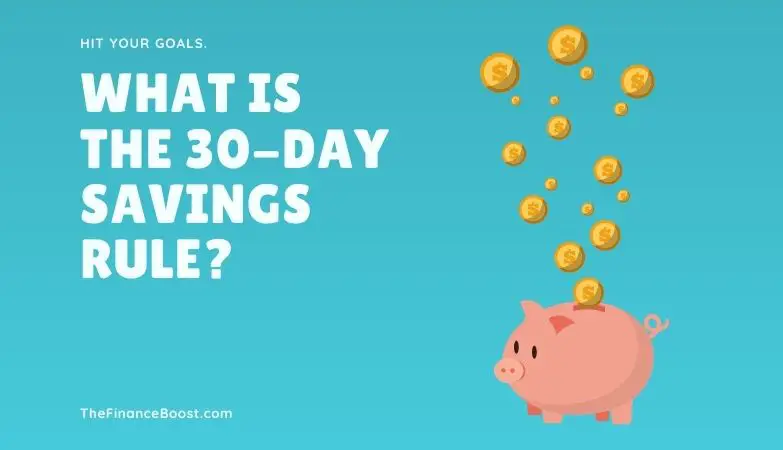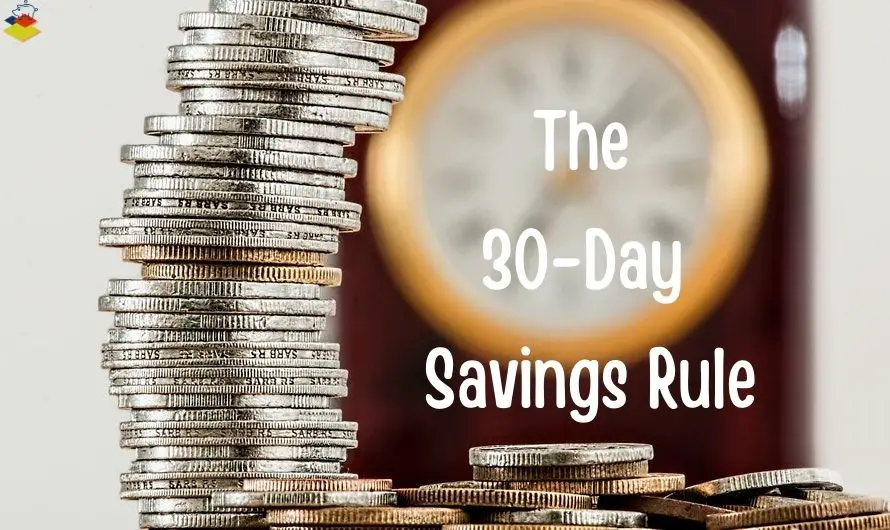The 30-Day Savings Rule is a savings technique that will help you curb impulse spending, thus, boosting your savings to reach your financial goals faster.
Whether you want to save more money or stop living paycheck to paycheck, this comfortable and unique saving strategy will transform your financial game.
A lot of times, we buy on impulse, like we are on autopilot mode, and this is usually based on emotions.
For instance, when you went grocery shopping one day, you passed by a shoe store right next to it. Your original plan was to check walk in the grocery store and get all items on your list, but you decided to walk into the shoe store to browse through.
The outcome is you giving in to the tiny voice in your head telling you to just go ahead and buy some shoes and you end up walking out with a bag of shoes you didn't even plan to buy or need.
Sounds familiar?
After a couple of days, there's a pang of guilt that engulfs you, and you wonder where all your money went. And the cycle goes on and on.
My friend, you've got to break that cycle and get that habit out of your system! Keep reading about the 30-Day Savings Rule to learn how.
Related:
32 Realistic Ways to Save Money Very Easily Without Giving up Too Much
What is the 30-Day Savings Rule?
The 30-Day Savings Rule is one of the easiest ways to save more money effectively. The primary purpose is to instill into your mindset the value of waiting.

Whenever you feel like buying a particular item, you shouldn't immediately purchase it without giving it a second thought. Make a mental note or a real post-it note about its price, location, and features. Deposit the amount to your savings account first. Then wait for 30 days (1 month) before making any purchasing decisions.
If you still want the item after the said lead time, go ahead and buy it. Otherwise, it stays in your savings account and boom! Easy money saved.
Doing this helps get in the habit of delayed gratification and saves you from buyer's remorse.
Buyer's remorse is when you feel regret right after purchasing. It can be overwhelming at times and makes you uneasy to the point of questioning if your purchase was worth it.
Most of the time, people are so accustomed to instant gratification and temporary bliss because that's how the human mind has always worked. That's why it will take a lot of determination and willpower to follow this rule.
Why use the 30-Day Savings Rule to Save money?
If you're looking for more ways to save money, this is a good starting point. Besides, 30 days is enough time to make an informed and rational decision.
You get to control impulse buying and spending with the 30-Day Savings Rule and save more money!
You'll also have peace of mind knowing that you won't wonder where all your money goes.
What's in it for you?
- Satisfaction: You gain a sense of pride once you successfully implement the rule for yourself, and after 30 days, you will honestly know whether you want that item and so will treasure it a bit more.
- Consideration time: Delaying your purchase by 30 days gives you time to consider whether it's something you need, or whether in reality, it's just a want. Besides, even if you want it enough to buy it still, at least it's no longer an impulse purchase but now a well-considered delayed purchase.
- No self-depriving – The 30-Day savings rule works so well because you're not depriving yourself. You get to say no to yourself for a little while without any feelings of self-deprivation. It's a win-win situation, yay! Eventually, you either buy something you truly long for after the month-long wait, or you save an extra bit of money.
How to get started? How does the 30-Day Savings Rule Work?
The 30-Day Savings Rule is easier than you think. Let me walk you through each easy step.

Step 1 – Whenever you're in a situation that calls for potential impulse buying, check in with yourself first. Ask yourself, will it really be worth the price, or will it just hurt my budget? Take time to assess the situation and your current emotions. After that, try to take down notes of all the details of that item. Its price, location, features, and so on.
Step 2 – Next, put the exact amount this item costs into a separate savings account – this is what you will use to buy it after 30 days if you still want it.
Step 3 – Then make a note of the start and end dates of your 30 days period.
Step 4 – After that, keep your notes someplace visible so you can consider those items during the following months. You can post it on your fridge, on your desktop, anywhere you have easy access to it.
Step 5– After 30 days, make your decision. Are you finally going to buy it or keep the savings?
Thinking deeply about the item/s is crucial because you can assess whether it will be worth it, how it will be of use to you, do you need it, and how will it enhance your life.
Keep in mind that the 30-Day Savings rule will be futile if you can't afford to buy the item in the first place. The bottom line is that this rule will help you to be better at your financial decisions.
You can't improve if you are going into debt for something, which may only be a want and not a need for you.
5 Tips to help you succeed with the 30-day savings rule

- Don't write down the items.
I know this is somewhat contradicting the above steps but think about it. Out of sight, out of mind! If you can't remember it after a month, then you aren't that serious about actually buying it. It's a false want or a need. Makes sense, right? - Shop online.
Fill your online cart with all the things you think you want or need but are hesitant to buy, then exit your browser or app and forget about it. - Put the item on your birthday list or Christmas wish list.
This tip is also one right way to save. You get your desired item as a gift at the expense of someone else, none other than your dear loved ones. - Do not take cash or use your cards.
Avoid taking excess cash with you, and do not use your credit cards when you go out. That way, you won't be tempted to make any further purchases. - Do more Research.
When you find something you want to buy, take or save a picture of it and find some other thrift store that may offer it for a lower price.
Make Saving a Challenge
If you're someone who loves taking on challenges, why not take your savings to another level? Like a Money-Saving Challenge? Qapital is a money app that helps to reach complete your savings challenges with set-and-forget rules other fun rules to supercharge your savings. The following are a few simple yet effective ideas on how to save money successfully.

○ Save Spare Change Challenge
For any spare coins or cash you get from every purchase, save it in your piggy bank or savings jar. Better yet use an app like Acorns to automatically do this for you. You'll be surprised by how much you can accumulate over time.
○ No Dining Out Challenge
Instead of eating out, try to be creative by making your meal at home. Use free coupons or saving apps at any local grocery and food stores. You can save a tremendous amount of dollars just by staying and eating at home.
○ Save $500 in 30 Days.
With this money-saving challenge, you can save $500 in just a month! By cutting back on your expenses and saving just a little every day, this money challenge is attainable. You can start every day by saving $17 daily or $125 weekly.
30-day Savings Rule FAQs
Does the 30-day rule help to control impulse buying?
Yes, it does. By delaying instant purchases, you have time to think and consider your needs or wants and priorities.
Whenever we ought to buy something, typically, we are misled by our emotions. We think we may need or want it for now when in reality, it just creates a hole in your budget.
How do I stick to it?
Start from within you. Ask yourself questions like what motivates you to save? What are your financial goals? Commit to achieving your financial dreams and goals. Remember, you can start anytime and anywhere you are.
Remind yourself that savings should be like second nature to you, and it will also be helpful if you have someone who can hold you accountable.
Add fun to this rule by sharing it with your friends or colleagues, whom you know you can count on for more fun and engaging savings technique.
How long does it take to build a habit?
Experts say that it takes three weeks for a solid habit to take place and get into your system. Do not worry if you find it too difficult for you. The first time is always the hardest; keep at it.
But, know that once you have set your mind to saving money and make it a priority, saving is a perfectly healthy habit for life.
Which is better? 50/20/30 Rule or 30-Day Savings Rule?
Of course, there are many rules or money-saving challenges out there you can try depending on your motivation and comfort level.
You've probably heard about the 50/20/30 rule. It's a budget technique that involves allocating 50% of your money to needs, 20% to savings, and 30% to wants.
Both improve your financial life and management. It depends on how you will tailor-fit it to your lifestyle. For example, you can make it 70/20/30 or 80/20 rule.
Learn More:
How to Budget and Save Money to Transform Your Finances.
5 Different Monthly Budgeting Techniques
The Final Word
Every one of us has had a fair share of the impulse buying experience. I used to catch myself indulging whenever I am at a local bookstore. I'll go in just to look at the books, but once I'm inside, it'll feel like I've found a home and want to buy as many books as I want.
It's left me remorseful and without money on several occasions. I learned my lesson, and instead of this, I check out books at a local library.
Whether you're making big or small purchases, it's essential to think about it first, especially when it isn't part of your budget. I also carefully analyze my thoughts whenever I feel like making a purchase that I probably shouldn't because I know how sneaky my mind can be at times.
Above all, savings should be an automatic response for you. The 30-day savings rule will make a difference in your spending habits.
You can live at peace knowing you're careful about your purchases and, at the same time, saving your money.
How about you? Have you used the 30-day rule? If so, Did it work out well for you? And would you recommend it to others? Comment down below to share your experience.
Spread the love. Get better at your finances!









0 Comments